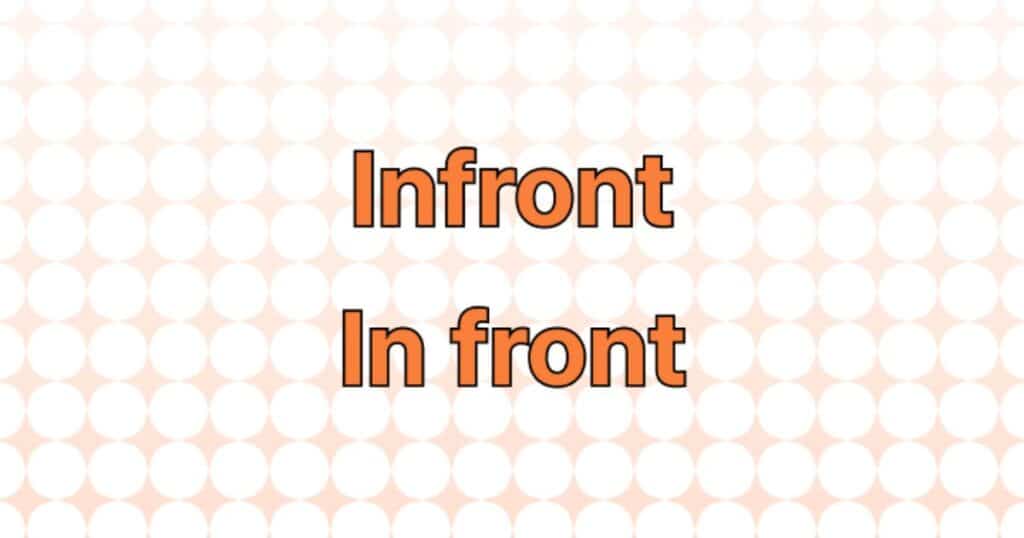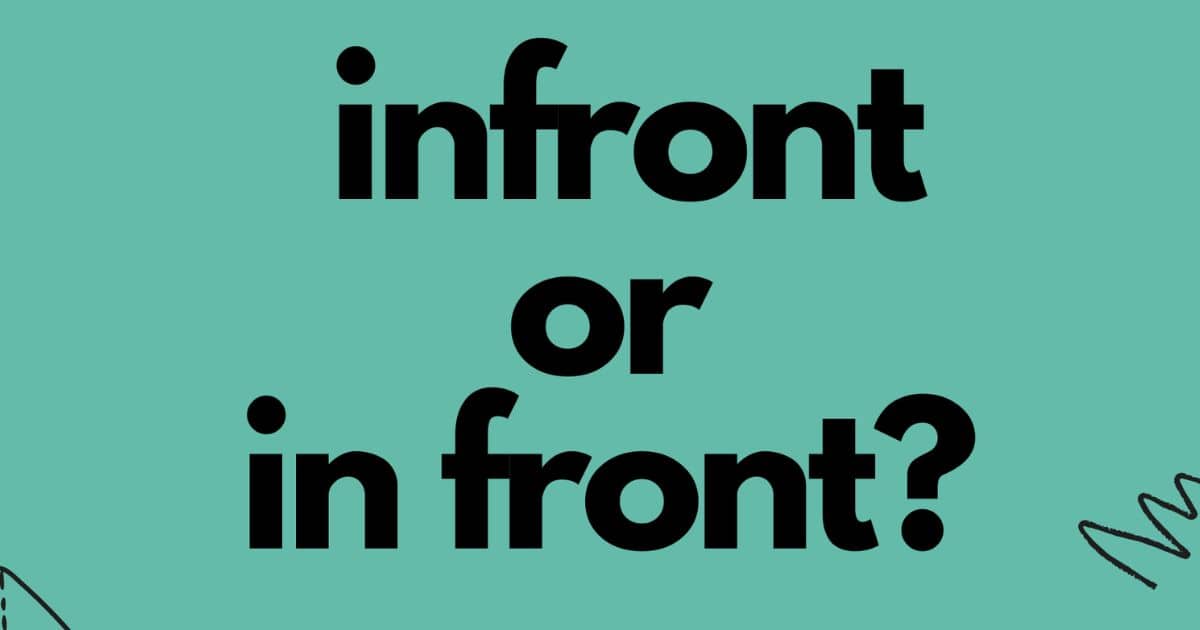This seemingly simple distinction can lead to confusion in both casual conversation and professional writing. Understanding the correct usage of the term not only enhances your communication skills but also reflects your attention to detail.
In this article, we will delve into the nuances of “infront” or “in front,” providing you with clarity that can elevate your writing.
Which One Is Correct? Infront or In Front?
If you’re wondering whether “infront” or “in front” is correct, here’s the answer: “in front” is the correct form. “Infront” is an incorrect spelling and does not exist in English grammar rules.
Why Is “Infront” Incorrect?
The phrase “in front” is a prepositional phrase, meaning it consists of a preposition (in) and a noun (front). In English, prepositions are not typically combined with nouns unless they form a recognized compound word.
Since “infront” isn’t a real word, using it in written communication or formal writing is a spelling mistake that can impact your writing clarity.
Common Mistakes
Many English learners and even native speakers mistakenly use “infront” due to phonetics it sounds like a single word when spoken quickly.
Here are some frequent errors:
Incorrect: She stood infront of the mirror.
Correct: She stood in front of the mirror.
Incorrect: The car stopped infront of the house.
Correct: The car stopped in front of the house.
Definition of “Infront”
There is no dictionary definition for “infront” because it is not an accepted word in traditional English. It is simply a typo or an incorrect spelling of “in front”.
Some people mistakenly assume it follows the pattern of words like “inside” or “into”, but unlike those, “in front” must remain separate to maintain grammatical precision.
30 Sentences Using the Word “In Front”
Here are 30 correct sentences using it to illustrate how it fits into different contexts:
- The kids played in front of the house.
- He parked his car in front of the hotel.
- She stood in front of the mirror to fix her hair.
- The bus stopped in front of the school.
- I placed my bag in front of my desk.
- We waited in front of the cinema.
- The teacher stood in front of the classroom.
- They met in front of the café.
- The monument is right in front of the museum.
- There was a crowd gathered in front of the stage.
- He walked in front of me.
- Please stand in front of the camera.
- She positioned her chair in front of the window.
- The dog sat in front of the fireplace.
- The boss sat in front of the employees.
- We saw a deer in front of the car.
- The ball rolled in front of the goal.
- The protest took place in front of the city hall.
- The shop is located in front of the park.
- I left my notebook in front of the computer.
- She placed her phone in front of her.
- He kneeled in front of the altar.
- The kids lined up in front of the teacher.
- The security guard stood in front of the entrance.
- The waiter placed the dish in front of me.
- The car pulled up in front of the gate.
- The man was standing in front of the elevator.
- The stadium is right in front of the train station.
- He stopped in front of the red light.
- She waited in front of the door.
Examples of “In Front”
To reinforce the correct usage of “in front”, here are some additional examples with explanations:
- Correct: The teacher wrote the answer in front of the class.
- (Shows spatial relationships between the teacher and the students.)
- Correct: He placed the documents in front of his manager.
- (Used in a professional situation.)
- Correct: There was a fountain in front of the museum.
- (Describes location context.)
Things You Need to Know About “In Front”
- “In front” is a prepositional phrase that expresses positional relationships.
- It describes something ahead of or before another object.
- Using “infront” in written communication is an error in writing.
- It is essential to follow grammar rules to ensure language accuracy.
READ MORE: TS Full Form In Chat: Decode Every Meaning Here
20 Points About Using Infront or In Front
- “In front” is the correct spelling.
- “Infront” is a common misspelling.
- Use “in front” to describe spatial positioning.
- It applies to both physical and figurative locations.
- Avoid “infront” in formal documents.
- Check spelling to maintain writing accuracy.
- Prepositions should not be combined incorrectly.
- Using “infront” weakens professional communication.
- Always proofread for grammatical precision.
- “In front” follows English syntax norms.
- Remember that “front” is a noun.
- Don’t confuse it with similar phrases.
- Spatial relationships require precise language.
- Formal writing demands correct spelling.
- Avoid language errors that reduce clarity.
- English grammar principles favor separate words.
- Typing fast can cause this common mistake.
- Spell-check tools can help spot “infront” errors.
- Students often make this typo in essays.
- Professionals should avoid this mistake in reports.
Definition of “In Front”
The phrase “in front” means “located ahead of or before something.” It follows English grammar standards and is used in both casual and formal writing.
Example of How “In Front” Can Be Used in Sentences
- Casual Writing: I parked my bike in front of the store.
- Professional Situations: The presenter stood in front of the audience.
Proper Usage of “In Front”
- Always write it as two separate words.
- Ensure effective communication by using the correct spelling.
- Apply it correctly in written language, especially in formal contexts.
Infront: Definition and Usage
“Infront” is not a correct English word. It is a common misspelling of “in front.” Many people mistakenly write “infront” because of how the phrase sounds when spoken quickly. However, it is incorrect in both formal writing and casual communication.

If you’re writing a business report, academic paper, or any professional document, using “infront” can make your work look unpolished. Always use the correct form: “in front.”
5 Synonyms for Infront
Since “infront” is incorrect, let’s list alternative words that convey similar meanings to “in front”:
- Ahead of – “The car was ahead of us on the road.”
- Before – “She arrived before everyone else.”
- Leading – “The runner was leading the race.”
- Prior to – “He completed the task prior to the deadline.”
- Foremost – “Honesty is foremost in our values.”
In Front: Definition and Usage
Examples of Usage:
“The cat sat in front of the fireplace.”
“She stood in front of the audience to give her speech.”
“There was a large tree in front of the house.”
“In front” is commonly used in written communication, including formal contexts like business documents and academic writing.
5 Synonyms for In Front
If you want to replace “in front” with similar expressions, here are some options:
- Ahead of – “The blue car is ahead of the red one.”
- Before – “He stood before the judge.”
- At the forefront – “She was at the forefront of innovation.”
- Preceding – “The introduction precedes the main content.”
- Facing – “He sat facing the door.”
Side-by-Side Comparison
| Feature | Infront (Incorrect) | In Front (Correct) |
|---|---|---|
| Grammar Type | Not a real word | Prepositional phrase |
| Spelling | Incorrect | Correct |
| Usage in Writing | Should be avoided | Used in all contexts |
| Meaning | No meaning in English | Describes location or position |
| Examples | “She stood infront of me.” | “She stood in front of me.” |
Everyday Usage Examples
“There was a long line in front of the store.”
“The monument stands in front of the museum.”
“She placed her coffee in front of the laptop.”
“A beautiful fountain is located in front of the building.”
“The professor stood in front of the whiteboard and explained the lesson.
Conclusion
The choice between “infront” or “in front” hinges largely on the context and conventional usage. While “in front” is the widely accepted form, understanding the nuances of both can enhance your writing clarity.
Always aim for precision in your language to convey your message effectively. Don’t let small details like this slip through; review your work carefully to ensure correctness.
FAQs
You don’t “infront” is not a correct English word. It is a common misspelling of “in front.”
Yes! “In front of” is a correct.
Correct: “The car is in front of the house.”
Incorrect: “The car is infront of the house.”
“Infront” is not a real word in standard English. It is an incorrect spelling of “in front.”

